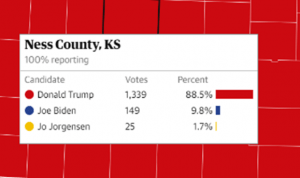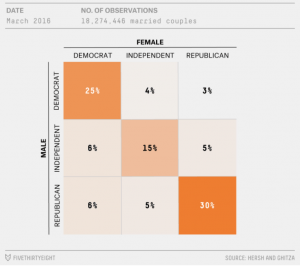Spread of conspiracy theory modelled through diffusion and clusters
Main Source:
MGp1VEhyWnFIbUlMbUpMa1grbElTUkNsNHNHNEpaR24zSW5zSTZCSlQwbFBXbWlLdEoySERGVVE9PSJ9
Supplementary Sources:
- https://fivethirtyeight.com/features/how-many-republicans-marry-democrats/
- https://pcl.stanford.edu/research/2014/iyengar-ajps-group-polarization.pdf
The spread of conspiracy theory has been greatly amplified by the prevalence of the internet and by social media where a large audience can be reached. The Covid-19 pandemic and the 2020 US election has also induced a wide variety of new conspiracy theories. It is especially interesting to see that conspiracy theories have political leanings and spread amongst both Democrats and Republicans. In this paper, I will first talk about how the polarized American society serves as a great example of clusters, and then explain how a new survey conducted by the Survey Centre on American Life in collaboration with the Centre on American Progress reflects diffusion of conspiracy theories into these groups.
There is a vast number of people in the US who are apolitical, evident from the voting turnouts every four years. However, amongst those who do care, politics represent a big fault line. In a 2016 study conducted by two researchers (Hersh & Ghitza 2016), it is shown that only 9% of all married couples had one Republican and one Democrat. In the Big Sort by political author and journalist Bill Bishop, he found out through investigation and data collection that American neighborhoods are becoming increasingly politically homogeneous. These studies are consistent with the results from 2020 election, where the vast majority of counties displayed results like the following (Source: The Guardian and Associated Press).
From these results, we can construct a big network of US with each voter as one distinct node. As ties tend to form when both nodes are geographically close or through marriage/family relationships, we can confidently separate the Democrats into one cluster and Republicans into the other. While technically the intergroup density should be calculated as the average proportion of Republican ties vs Democrats ties a Democrat has (vice versa for Republicans), this is very difficult to calculate. Instead, I will use the intermarriage results from Hersh & Ghitza to estimate these proportions. Assume every person has an equal chance of marrying each person they have strong ties to, then since bipartisan marriage sits at 9% while partisan marriage sits at 55%, the group density would be 55/64, with every person having 55 Democrat ties for every 9 Republican ties.
With these in mind, it is not difficult to explain the results from a survey on conspiracy and misinformation Survey Centre on American Life conducted in September 2020 just prior to the election. This survey covered a wide variety of topics that are of interest to both political parties, such as Russian collusion, Covid-19 conspiracies, and election fraud. The responses show a clear partisan division line, with certain theories more prevalent in one party than the other. 42% of Republicans believe that “Hydroxychloroquine is a safe and effective way to treat Covid-19”, while only 5% of Democrats believe this. Republicans are also more likely to believe in other political conspiracy theories such as “Obama’s birth certificates are forged” and “there are active agents undermining the 2020 election”. Most importantly, the survey found out that “Republicans who report having a mixed friendship network—having at least some Democratic and Republican friends—are less likely to believe Obama was born outside the US than are those with only Republican friends (25% vs. 41%)”.
These are important observations that can be explained with the network diffusion theory. Since not every person is vulnerable to conspiracy theories, we can think of conspiracy spread like an epidemic, with probability p < 1 of those that receive this information will believe in it. The interesting thing about conspiracy theories is that once someone believes in it, they rarely get cured unlike a disease such as Covid-19. Take the Hydroxychloroquine theory as our example, we start with one Republican node with ties to all Republicans and very few Democrats: Donald Trump. We will have p proportion of the Republican population believing in this theory, and very few Democrats. The theory then spreads within the Republican cluster until it reaches saturation: those that is vulnerable to conspiracy theory have already believed in it, and those that are not vulnerable to conspiracy theory does not believe in this. There is a large enough initial number and exposure to cascade this phenomenon across the entire cluster. On the other hand, since there are very few initial Democrats that believe in this conspiracy theory, and hence not enough to create a complete cascade. The resistance level (vulnerability to Hydroxychloroquine theory) within the Democrats is also higher due to political affinity. Theories like Russian collusion with Trump is also widely believed in the Democratic voter base compared to Republicans because the “initiators” of these theories are from the Democrats, and hence a larger number of Democrats will be sufficient to cause a diffusion cascade within their base compared to Republicans.
From examples like this, we can infer that the results of the survey are consistent with diffusion theory. Since both clusters have a high-density number (as we have calculated above), it is very difficult for conspiracy theories to spread from one cluster to the other. If a Republican has both Democratic and Republican friends, he/she would have a lower proportion of Republican theory believers and hence are less likely to believe in them. This inference is consistent with the result of the survey.
Despite social media facilitating the transfer of information across clusters, if the behaviours of those around you don’t change, then it is unlikely that you would change behaviour solely based on internet strangers. As a result, there is still strong support for the diffusion model when studying the spread of conspiracy theories.



